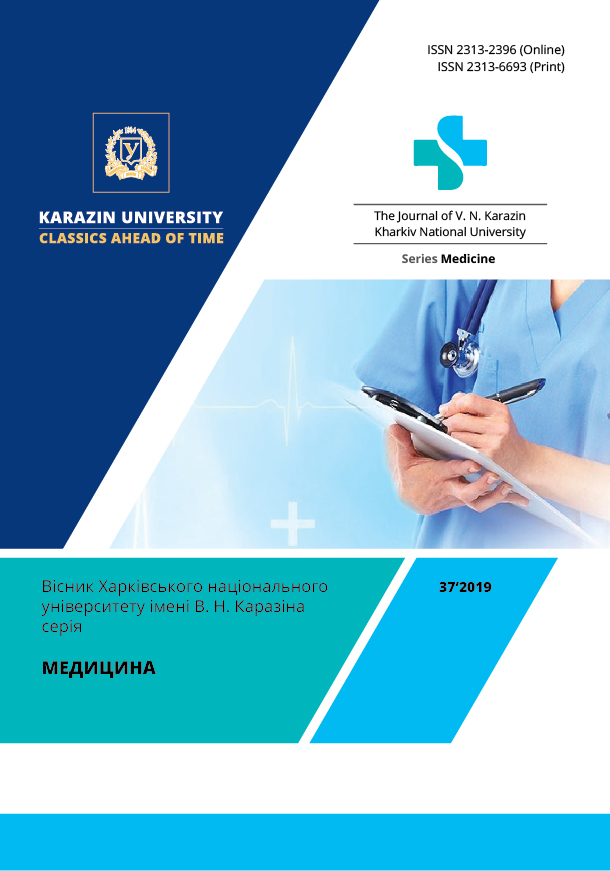Two-stage surgical treatment of subarachnoid and paryhymatous blood effects with the use of endovascular embolization of damaged aneurysm
Abstract
Introduction. Aneurysmal subarachnoid hemorrhage (SAH) is complicated by concomitant intracerebral hemorrhage (IUD) with a frequency of 4% to 42.5%. More than 80% of patients die in conservative therapy, and when removing only hematomas without occlusion of an aneurysm, the mortality rate reaches 75%. Objectives. The aim of the study was the optimization of treatment of aneurysmatic subarachnoid haemorrhage complicated by the formation of intracerebral hematoma. Materials and methods. The analysis of the results of surgical treatment of 101 patients in the acute period of cerebral aneurysm rupture was performed. The first group of observations in which the surgical treatment was limited to endovascular occlusion of cerebral aneurysms. In the second group of observations, multi-stage surgical treatment was performed - endovascular embolization of cerebral aneurysm with subsequent removal of parenchymal hematoma for 24–48 hours. Results. In most cases, surgical treatment was limited to endovascular embolization of the ruptured aneurysm. In 3 observations, multistage surgical treatment was performed - endovascular embolization of cerebral aneurysm with subsequent removal of intracerebral hematoma. In two cases, positive dynamics with a regression of neurological deficits in the postoperative period was noted. In one observation, partial regression of motor deficit. Conclusions. Two - stage surgical treatment of subarachnoid haemorrhage with intracerebral hematoma the use of endovascular embolization of the ruptured aneurysm and subsequent evacuation of hematoma is effective and can be used in cases where there is a technical possibility of occlusion of the aneurysm s and the compensated state of the patient.
Downloads
References
Konovalov A.N., Krylov V.V., Filatov Yu.M. and others. (2006) The recommended protocol for managing patients with subarachnoid hemorrhage due to rupture of cerebral aneurysms // Vopr. neurohir. them. N.N. Burdenko. № 3. P. 3–10.
Nowak G, Schwachenwald D, Schwachenwald R, Kehler U, Müller H, Arnold H. (1998) Intracerebral hematomas caused by aneurysm rupture. Experience with 67 cases // NeurosurgRev. V. 21, № 1. P. 5–9. PubMed PMID: 9584279.
Іohnstedt B.N., Nguyen H.S., Kulwin C.G., and others. (2013) Outcomes for clip ligation and hematoma evacuation associated with 102 patients with ruptured middle cerebral artery aneurysms //World Neurosurg. Sep-Oct. V. 80, № 3–4. Р. 335–41. doi: 10.1016/j.wneu.2012.03.008.
Prat R, Galeano I. (2007) Early surgical treatment of middle cerebral artery aneurysms associated with intracerebral haematoma // Clin. Neurol.Neurosurg. Jun V. 109, № 5, Р. 431–5. Epub 2007 Apr 20. PubMed PMID: 17449171.
de los Reyes K., Patel A., Bederson J.B., FronteraJ.A. (2013) Management of subarachnoid hemorrhage with intracerebral hematoma: clipping and clot evacuation versus coil embolization followed by clot evacuation // J Neurointerv Surg. Mar. V. 5, № 2, P. 99–103. doi: 10.1136/neurintsurg-2011-010204.
Jeong J.H., Koh J.S., Kim E.J., (2007) A less invasive approach for ruptured aneurysm with intracranial hematoma: coil embolization followed by clot evacuation // Korean J. Radiol. Jan-Feb. V. 8, № 1. Р.2–8. PubMed PMID: 17277557.
Tawk R.G., Pandey A., Levy E., Liebman K., Rosenwasser R., Hopkins L.N., Veznedaroglu E. (2010) Coiling of ruptured aneurysms followed by evacuation of hematoma // World Neurosurg. Dec. V. 74, № 6. P. 626–31. doi: 10.1016/j.wneu.2010.06.051.
Salaud C., Hamel O., Riem T., Desal H., Buffenoir K. (2016) Management of aneurysmal subarachnoid haemorrhage with intracerebral hematoma: Is there an indication for coiling first? Study of 44 cases // Interv Neuroradiol. Feb. V. 22, № 1. P. 5–11. doi:10.1177/1591019915617320.
Sehba F.A., Friedrich V. (2015) Early events after aneurysmal subarachnoid hemorrhage // Acta Neurochir Suppl. № 120. P. 23-8. doi: 10.1007/978-3-319-04981-6_4.
10. Tokuda Y., Inagawa T., Katoh Y., Kumano K., Ohbayashi N., Yoshioka H. (1995) Intracerebral hematoma in patients with ruptured cerebral aneurysms // Surg Neurol. Mar. V. 43, № 3. P. 272–7. PubMed PMID: 7792692.
Jeong J.H., Koh J.S., Kim E.J. (2007) A less invasive approach for ruptured aneurysm with intracranial hematoma: coil embolization followed by clot evacuation. // Korean J. Radiol. Jan-Feb. V. 8, № 1. P. 2–8. PubMed PMID: 17277557.
The Journal of V. N. Karazin Kharkiv National University, series Medicine has following copyright terms:
- Authors retain copyright and grant the journal right of first publication with the work simultaneously licensed under a Creative Commons Attribution License that allows others to share the work with an acknowledgement of the work’s authorship and initial publication in this journal.
- Authors are able to enter into separate, additional contractual arrangements for the non-exclusive distribution of the journal’s published version of the work, with an acknowledgement of its initial publication in this journal.
- Authors are permitted and encouraged to post their work online prior to and during the submission process, as it can lead to productive exchanges, as well as earlier and greater citation of published work.




